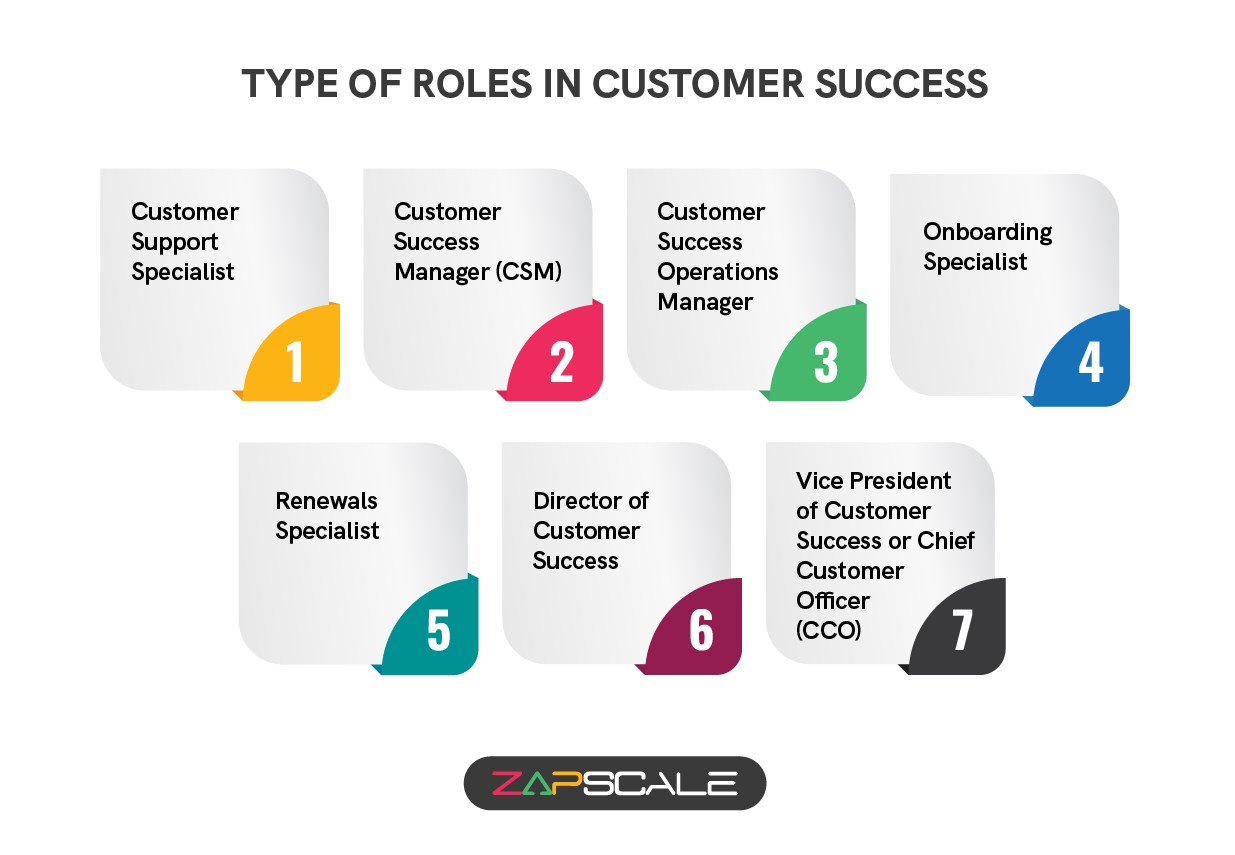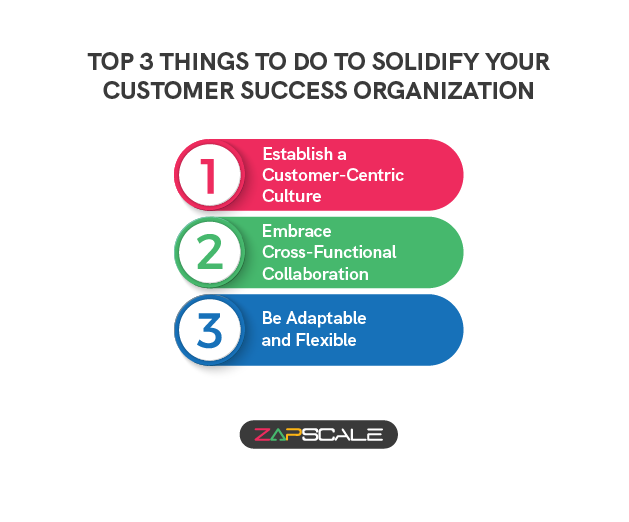CATEGORY > Customer Success Management
How To Build A World-Class Customer Success Organization?

Delighted customers are super important for SaaS businesses to continue functioning and achieve their best potential.
Hence, SaaS companies are turning to strong customer success teams to keep customers happy and reduce churn.
As these teams grow, a well-defined organizational structure becomes crucial. Learn how to build a rock-solid customer success organization that keeps churn low and happiness high!
Customer Success Organization - An Overview
A customer success organization's primary goal is to ensure that customers succeed with the company's products or services.
This arrangement strives to keep customers satisfied, limit attrition, and foster long-term connections.
Customer success organizations help businesses grow and retain customers by staying in touch with them, providing training, and listening to feedback.
Customer Success Team: Roles and Responsibilities
In a customer success organization, every individual has a distinct role to play. Let’s meet the dedicated specialists that dominate the customer success arena.

1. Customer Support Specialist
Customer Support Specialists enable high levels of satisfaction among customers.
These specialists manage and respond quickly to daily customer inquiries.
They are skilled in troubleshooting issues, providing technical assistance, and ensuring that customers receive timely support.
Reports to: Customer support manager or Director of customer support
2. Customer Success Managers (CSM)
They are responsible for knowing their customer’s objectives, problems, and expectations. CSMs proactively engage with customers to ensure they get the most out of the product or service.
Moreover, customer success managers play a critical role in developing strong relationships and increasing customer satisfaction.
Reports to: Director of Customer Success or Vice President of Customer Success
3. Customer Success Operations Manager
An Operation Manager optimizes procedures and workflows within the customer success team. They adopt best practices, tweak systems for efficiency, and guarantee that multiple operations work together seamlessly.
Operations managers play an important role in increasing team productivity and providing consistent customer experiences.
Reports to: Vice President of Customer Success or Chief Customer Officer
4. Onboarding Specialist
These professionals assist new users with the initial setup and execution of a product or service. Effective onboarding creates the foundation for long-term success and retention.
They guarantee a smooth transition by providing training on features and functionalities and assisting customers in achieving their goals swiftly.
Reports to: Onboarding Manager or Director of Customer Success
5. Renewals Specialist
Renewal specialists manage contract renewals and upsell opportunities to retain existing customers.
They develop customer relationships, understand their changing needs, and suggest solutions that are in line with their business goals.
This way they ensure additional income generation for SaaS businesses.
Reports to: Renewals Manager or Director of Customer Success
6. Director Of Customer Success
The director leads the customer success team, driving strategy, instructing managers, and ensuring that customer needs are satisfied.
They work across departments to align projects with company goals, track performance indicators, and report back to senior leadership on customer results.
Reports to: Vice President of Customer Success or Chief Customer Officer
7. Vice President of Customer Success or Chief Customer Officer (CCO)
As the senior person in line, the VP or CCO is responsible for augmenting the strategic direction of the CS team.

They oversee executive-level customer advocacy, manage overall operations and resources, align efforts with company goals, and reduce customer satisfaction risks while cultivating industry leadership and important partnerships.
Reports to: CEO or COO
Customer Success Models: Unified Success
Let’s look at different customer success models for creating top-notch business strategies.
1. Tiered Support Model
The tiered support model divides customer relationships into multiple tiers, with each receiving a unique amount of care and attention based on their importance and complexity.
a. Structure
Customers are divided into tiers (e.g., high-value, medium, and low) based on revenue or complexity. Each tier is allocated a specialized CSM with expertise specific to their customer group.
b. Potential
High-value customers are assigned dedicated CSMs, ensuring efficient resource allocation and awareness of unique customer demands.
c. Ideal for
Companies with a varied customer base, where high-value accounts necessitate particular attention.
2. Lifecycle Management Model
This approach carefully guides the customer journey from onboarding to renewal and expansion, maximizing satisfaction and loyalty at each stage.
a. Structure
Teams here concentrate on important phases such as onboarding, adoption, expansion, and renewal, with each having specific skills.
b. Potential
Aligns targeted support with the customer's lifecycle stage, increasing efficiency and customer success outcomes.
c. Ideal for
Suitable for businesses with complicated products whose customer support requirements evolve along with their adoption journey.

3. High-Touch Model
A high-touch model prioritizes customized support and involvement, especially for high-value or strategic accounts.
a. Structure
Relies on specialized customer success managers to cultivate strong connections and deliver tailored support throughout the customer journey.
b. Potential
Promotes strong customer relationships through tailored assistance, resulting in improved retention and satisfaction rates.
c. Ideal for
Suitable for businesses with high-value accounts, complex products, or a relationship-driven sales strategy that necessitates close customer interaction and proactive solutions.
4. Low-Touch Model
The low-touch customer success model focuses on providing quick help and guidance via automated interactions and self-service tools.
a. Structure
Deploys automation technologies, self-service portals, and scalable solutions to allow customers to handle issues on their own.
b. Potential
Allows customer success teams to prioritize strategic projects by being cost-effective and scalable.
c. Ideal for
Suitable for businesses with huge customer bases or basic products. Particularly useful for organizations that provide freemium or starter plans.
5. Hybrid Model
This successful methodology combines multiple approaches to produce a customized approach for diverse customer requirements and company settings.
a. Structure
Combines aspects from all of the aforementioned customer success organization models to fully maximize customer success initiatives.
b. Potential
Provides flexibility and customization, harnessing strengths from multiple models to maximize customer success.
c. Ideal for
Excellent for businesses with a wide range of customer sizes and complexities. Allows for adaptation and scalability while preserving individualized customer engagement and operational efficiency.
Map Your Customer Success Org Chart
Here’s a comprehensive hierarchical overview of customer success org. chart for your thorough reference.
1. Chief Customer Officer (CCO)
- Determines strategic direction and vision for customer success.
- Advocates for customer desires at the executive level.
- Oversees the alignment of customer success with company-wide goals.
- Leads the whole customer success organization.
- Reports directly to the CEO (Chief Executive Officer).
2. VP Of Customer Success
- Develops and implements a customer success plan.
- Manages the department's operations and performance.
- Aligns customer success goals with long-term corporate objectives.
- Manages senior CSMs, support, onboarding, renewals, and operations teams.
- Reports to the CCO or the CEO
3. Customer Success Director
- Supports the VP of customer success in departmental management.
- Manages certain customer categories or geographies.
- Creates ways to increase overall customer happiness and retention.
- Manages a group of senior CSMs or certain operational duties within customer success.
- Reports to the vice president of customer success.
4. Customer Success Managers (CSMs)
- Develops strategic partnerships with key accounts.
- Create and implement customer success plans.
- Manage complex or high-value accounts.
- Ensure consumer pleasure and adoption.
- Report to the vice president or director of customer success.
5. Onboarding Team Lead
- Manages the onboarding process for new customers.
- Creates and implements customized onboarding plans.
- Coordinates with the sales, customer success, and product teams.
- Monitors onboarding metrics and optimizes processes.
- Reports to the vice president of customer success.
6. Training Specialists
- Creates specialized training sessions for customers.
- Develop training materials and resources.
- Collaborates with the product management and customer success teams.
- Evaluate training effectiveness and collect feedback.
- Reports to the vice president of customer success or the training manager.
7. Customer Operations Director
- Supports the VP of customer success with operational management.
- Manages tools, analytics, and process optimization.
- Develops strategies for increasing operational efficiency.
- Manages operational team within customer success.
- Reports to the VP of customer success
8. Customer Engagement Manager
- Develop customer engagement tactics.
- Improves overall customer experience and satisfaction.
- Analyzes data to help improve engagement initiatives.
- Collaborates with the sales, marketing, and customer success departments.
- Reports to the VP of customer success or directly to the CCO.
How To Solidify Your Customer Success Organization?
Creating a customer success organisation requires clarity and diligence.
Here are some tips to help you out with this activity.

1. Establish a Customer-Centric Culture
Create a culture in which every team member values customer happiness while emphasizing empathy and proactive problem-solving. Encourage the team to exceed expectations by fostering trust and long-term connections for mutual achievement.
2. Embrace Cross-Functional Collaboration
Create regular collaboration channels between the customer success, sales, product, and support departments. Share customer data and feedback effortlessly to better align strategies and improve the overall customer experience.
3. Be Adaptable And Flexible
Flexible customer success teams can quickly alter strategy, invent solutions, and grasp new opportunities to maintain competitiveness and drive growth. So, stay adaptable to shifting customer demands, market trends, and industry dynamics.
Conclusion
To conclude, a great customer success organization retains satisfied customers and ensures long-term business success.
By prioritizing customer satisfaction and operational excellence, SaaS brands can develop loyalty and drive long-term growth in competitive marketplaces.
ABOUT THE AUTHOR
Popular from Customer Success Management
Quality Content,
Straight To Your Inbox!
Subscribe for the latest blogs, podcasts, webinars, and events!

Write a Blog
If you have experience in CS and
a flair for writing, we’d love to
feature you.
Write to us on
hello@zapscale.com





